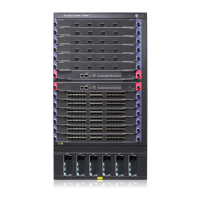102
Ste
Command
Remarks
5. Enter the interface view of an
MPLS TE link.
interface interface-type
interface-number
N/A
6. Enable interface MPLS TE.
mpls te Disabled by default.
7. Return to system view.
quit N/A
8. Create a tunnel interface and
enter its view.
interface tunnel tunnel-number N/A
9. Assign an IP address to the
tunnel interface.
ip address ip-address netmask Optional.
10. Set the tunnel protocol to
MPLS TE.
tunnel-protocol mpls te N/A
11. Configure the destination
address of the tunnel.
destination ip-address N/A
12. Configure the tunnel ID of the
tunnel.
mpls te tunnel-id tunnel-id N/A
13. Submit the current tunnel
configuration.
mpls te commit N/A
For more information about tunnel interfaces, see Layer 3—IP Services Configuration Guide.
Creating an MPLS TE tunnel over a static CR-LSP
Creating MPLS TE tunnels over static CR-LSPs does not involve configuration of tunnel constraints or the
issue of IGP TE extension or CSPF. Create a static CR-LSP and a TE tunnel using static signaling and then
associate them.
Despite its ease of configuration, the application of MPLS TE tunnels over static CR-LSPs is restricted
because they cannot dynamically adapt to network changes.
Static CR-LSPs are special static LSPs. They share the same constraints and use the same label space.
Before you perform the configuration, complete the following tasks:
• Configure static routing or an IGP protocol to make sure all LSRs can reach each other.
• Configure basic MPLS.
• Configure basic MPLS TE.
Follow these guidelines when you create an MPLS TE tunnel over a static CR-LSP:
• The tunnel-name argument in the static-cr-lsp ingress command must be the same as the tunnel
interface name, including the letter case. Assume you create a tunnel interface with the interface
tunnel 2 command. The tunnel-name in the static-cr-lsp ingress command must be in the form of
Tunnel2—not tunnel2 or TUNNEL2. Otherwise, the tunnel cannot be established on the ingress
node. This restriction however does not apply to transit or egress nodes.
• Do not configure the next hop address as a local public address when configuring the static CR-LSP
on the ingress or a transit node.
To create an MPLS TE tunnel over a static CR-LSP:
Ste
Command
Remarks
1. Enter system view.
system-view N/A

